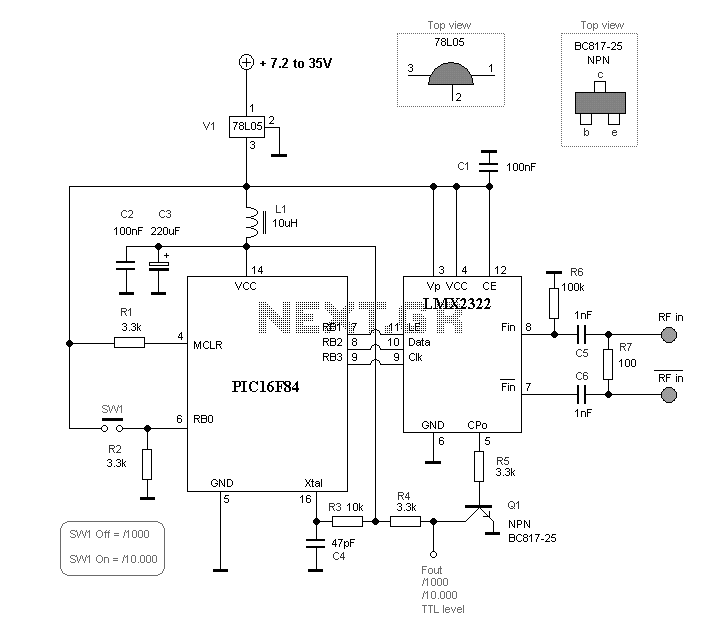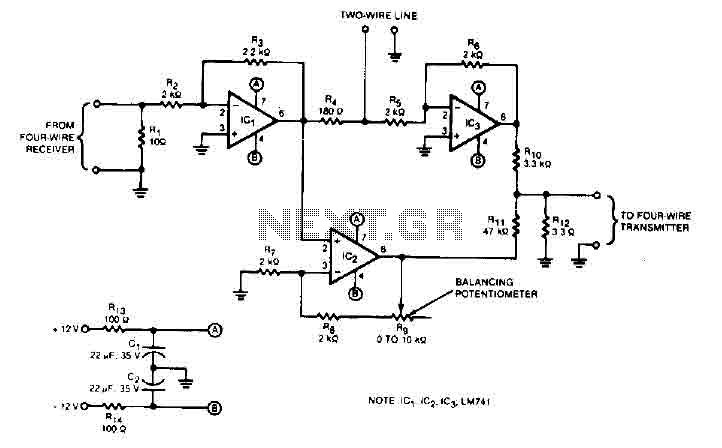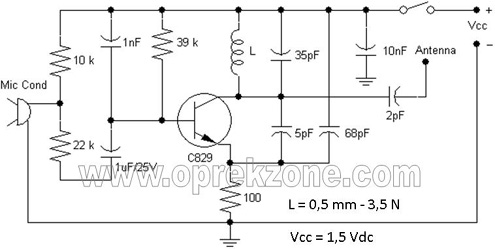
Multi Wire Cable Tester

A multi-wire cable tester features a separate LED indicator for each wire. It is capable of detecting open circuits, short circuits, reversals, earth faults, and continuity, utilizing four integrated circuits (ICs). Initially designed for intercom systems, it is also applicable for alarm wiring, CAT 5 cables, and more. For clarity, the circuit diagram does not display power supplies for the CMOS 4011 and CMOS 4050 ICs. The positive terminal of the battery connects to Pin 14 of each IC, while the negative terminal connects to Pin 7. The CMOS 4017 uses Pins 16 and 8, respectively. It is important to note that since the CMOS 4050 is a hex buffer, two chips are required to achieve eight gates, with the unused inputs grounded. The circuit consists of a transmitter and receiver, with the cable under test linking the two. The transmitter operates as an "LED chaser," where the 4011 IC is configured as an astable multivibrator, clocking a 4017 decade counter divider. The 4017 is set to reset on the ninth pulse, causing each LED to light sequentially from LED 1 to LED 8 before repeating the cycle. Due to the limited driving capability of the 4017, each output is buffered by a 4050 to provide sufficient current for long cables and the transmitter and receiver LEDs. The receiver consists of eight LEDs connected to a common wire.
The pinout for the CMOS 4017B is provided, with alternate naming for clarity. Testing each wire individually poses a challenge; for instance, if seven individually addressable LEDs are used, an eighth return or common wire would be necessary. Testing eight wires would require a ninth wire, which is impractical unless using a domestic earth connection. However, this is not advisable, as it may lead to erroneous results if the cable shorts to earth. The solution lies in recognizing that this is a logic circuit with two states: high or low. The 4017 outputs can serve as a common return path for an LED. For example, LEDs 1 to 3 utilize the fourth output of the 4017, which is set to zero, while the fourth LED is connected in reverse polarity. On the fourth pulse, output 4 is high, and output 3 is low, resulting in the LED lighting up. If the common return wire is open, LEDs 1 to 4 will not illuminate. A similar principle applies to outputs 5 to 8, allowing any output terminal from the 4017 to serve as the common return wire while adhering to the same operational rules.
The capability to quickly test all wires is a significant advantage, despite the minor limitation. When testing a cable with four or six wires, the connections must align with the LEDs numbered 1 to 4 or 1 to 6, respectively. With a properly functioning cable and all wires connected, LED 1 will light up at both ends, followed sequentially by LEDs 2, 3, 4, and so on, until LED 8, after which the sequence will repeat. For a four-wire cable, it must be configured to use the common return wire as previously described, resulting in a sequence of LED 1, 2, 3, and 4, with a delay as the four unused outputs are cycled through. To check for earth contact faults, the probe labeled "to earth connection" should be connected to a local earth. A wire that is grounded will cause the LEDs at both ends of the cable to dim or extinguish. An LED that does not light at the receiver indicates an open or broken circuit. In the case of a short circuit between two wires, such as wires 3 and 4, the receiver will display a sequence of 1, 2, 34, 43, 5, 6, 7, and 8. A reversal of wires will be indicated by an irregular LED sequence. For instance, if the probe is connected to earth at the transmitter, and the cable has multiple faults—wire 1 functioning correctly, wire 2 grounding, wires 3 and 5 reversed, wire 4 operational, wire 6 open, and wires 7 and 8 shorted—the LED sequence will reflect these conditions.A multi wire cable tester with a separate LED for each wire. Will show open circuits, short circuits, reversals, earth faults, continuity and all with four IC`s. Designed initially for my intercom, but can be used with alarm wiring, CAT 5 cables and more. Please note that for clarity this circuit has been drawn without showing power supplies to th e CMOS 4011 and CMOS 4050 IC`s. The positive battery terminal connects to Pin 14 of each IC and negative to Pin 7. The CMOS 4017 uses Pin 16 and Pin 8 respectively. Note also that as the CMOS 4050 is only a hex buffer, you need 8 gates so two 4050`s are required, the unused inputs are connected to ground (battery negative terminal). The circuit comprises transmitter and receiver, the cable under test linking the two. The transmitter is nothing more than a "LED chaser" the 4011 IC is wired as astable and clocks a 4017 decade counter divider.
The 4017 is arranged so that on the 9th pulse, the count is reset. Each LED will light sequentially from LED 1 to LED 8 then back to LED 1 etc. As the 4017 has limited driving capabilities, then each output is buffered by a 4050. This provides sufficient current boost for long cables and the transmitter and receiver LED`s. The receiver is simply 8 LED`s with a common wire. read on. The pinout for the CMOS 4017B is shown below. Please note that in the main schematic above, alternate naming of the pins has been used. The pin eqivalence is as follows:- Not a mistype. The problem with testing each wire individually is that if you had 7 individually addressable LED`s, then you would need an eighth return or common wire. In the case of testing 8 wires you would need a ninth wire. You could use a domestic earth but its not really practical, and also if the cable was shorting to earth anyway it would be no good anyway.
The solution had me thinking for a while, but since this is a logic circuit, there are only two conditions, logic high or zero. As the 4017 outputs are either high or low, any output can provide a common return path for a LED. So LED`s 1 - 3 use the 4th output of the 4017, which will be zero, and the 4th LED is wired with reverse polarity.
On the 4th pulse, output 4 is high, output 3 is low and so the LED will light. If the common return wire is open circuit then LEDs 1-4 will not light. A similar situation occurs with outputs 5 to 8. The common wire in can be taken from any output terminal from the 4017, but the same rule would still apply. The ability to test all wires quickly outweighs this small disadvantage. If a cable of just 4 or 6 wires is tested then it must use the wires with LED`s numbered 1 to 4 or 1 to 6, which is why the LED`s are numbered that way.
With a good cable and all wires connected then LED 1 will light at both cable ends, followed in sequence by LED 2, 3, 4 etc to LED 8, the sequence then repeating. If a 4 wire cable is used, it must be connected to use the common return wire as described in the preceeding paragraph.
The sequence would be LED 1, 2, 3, 4 repeating with a delay as the 4 unused outputs are stepped through. To check for earth contact faults, the probe labeled "to earth connection" would be physically connected to a local earth.
A wire that is earthing will dim or extinguish the LED`s at both ends of the cable. An LED not lighting at the receiver, indicates a broken or open circuit. If two wires are short circuit, example 3 and 4 then at the receiver the sequence would be 1, 2, 34, 43, 5, 6, 7, 8. A reversal would be indicated by an out of pattern sequence of LED`s. Here`s an example, the probe is connected to an earth at the transmitter, the cable is very faulty, wire 1 is OK, 2 is earthing, 3 and 5 are reversed 4 is OK, 6 is open circuit and 7 and 8 are short circuit.
See below. 🔗 External reference
The pinout for the CMOS 4017B is provided, with alternate naming for clarity. Testing each wire individually poses a challenge; for instance, if seven individually addressable LEDs are used, an eighth return or common wire would be necessary. Testing eight wires would require a ninth wire, which is impractical unless using a domestic earth connection. However, this is not advisable, as it may lead to erroneous results if the cable shorts to earth. The solution lies in recognizing that this is a logic circuit with two states: high or low. The 4017 outputs can serve as a common return path for an LED. For example, LEDs 1 to 3 utilize the fourth output of the 4017, which is set to zero, while the fourth LED is connected in reverse polarity. On the fourth pulse, output 4 is high, and output 3 is low, resulting in the LED lighting up. If the common return wire is open, LEDs 1 to 4 will not illuminate. A similar principle applies to outputs 5 to 8, allowing any output terminal from the 4017 to serve as the common return wire while adhering to the same operational rules.
The capability to quickly test all wires is a significant advantage, despite the minor limitation. When testing a cable with four or six wires, the connections must align with the LEDs numbered 1 to 4 or 1 to 6, respectively. With a properly functioning cable and all wires connected, LED 1 will light up at both ends, followed sequentially by LEDs 2, 3, 4, and so on, until LED 8, after which the sequence will repeat. For a four-wire cable, it must be configured to use the common return wire as previously described, resulting in a sequence of LED 1, 2, 3, and 4, with a delay as the four unused outputs are cycled through. To check for earth contact faults, the probe labeled "to earth connection" should be connected to a local earth. A wire that is grounded will cause the LEDs at both ends of the cable to dim or extinguish. An LED that does not light at the receiver indicates an open or broken circuit. In the case of a short circuit between two wires, such as wires 3 and 4, the receiver will display a sequence of 1, 2, 34, 43, 5, 6, 7, and 8. A reversal of wires will be indicated by an irregular LED sequence. For instance, if the probe is connected to earth at the transmitter, and the cable has multiple faults—wire 1 functioning correctly, wire 2 grounding, wires 3 and 5 reversed, wire 4 operational, wire 6 open, and wires 7 and 8 shorted—the LED sequence will reflect these conditions.A multi wire cable tester with a separate LED for each wire. Will show open circuits, short circuits, reversals, earth faults, continuity and all with four IC`s. Designed initially for my intercom, but can be used with alarm wiring, CAT 5 cables and more. Please note that for clarity this circuit has been drawn without showing power supplies to th e CMOS 4011 and CMOS 4050 IC`s. The positive battery terminal connects to Pin 14 of each IC and negative to Pin 7. The CMOS 4017 uses Pin 16 and Pin 8 respectively. Note also that as the CMOS 4050 is only a hex buffer, you need 8 gates so two 4050`s are required, the unused inputs are connected to ground (battery negative terminal). The circuit comprises transmitter and receiver, the cable under test linking the two. The transmitter is nothing more than a "LED chaser" the 4011 IC is wired as astable and clocks a 4017 decade counter divider.
The 4017 is arranged so that on the 9th pulse, the count is reset. Each LED will light sequentially from LED 1 to LED 8 then back to LED 1 etc. As the 4017 has limited driving capabilities, then each output is buffered by a 4050. This provides sufficient current boost for long cables and the transmitter and receiver LED`s. The receiver is simply 8 LED`s with a common wire. read on. The pinout for the CMOS 4017B is shown below. Please note that in the main schematic above, alternate naming of the pins has been used. The pin eqivalence is as follows:- Not a mistype. The problem with testing each wire individually is that if you had 7 individually addressable LED`s, then you would need an eighth return or common wire. In the case of testing 8 wires you would need a ninth wire. You could use a domestic earth but its not really practical, and also if the cable was shorting to earth anyway it would be no good anyway.
The solution had me thinking for a while, but since this is a logic circuit, there are only two conditions, logic high or zero. As the 4017 outputs are either high or low, any output can provide a common return path for a LED. So LED`s 1 - 3 use the 4th output of the 4017, which will be zero, and the 4th LED is wired with reverse polarity.
On the 4th pulse, output 4 is high, output 3 is low and so the LED will light. If the common return wire is open circuit then LEDs 1-4 will not light. A similar situation occurs with outputs 5 to 8. The common wire in can be taken from any output terminal from the 4017, but the same rule would still apply. The ability to test all wires quickly outweighs this small disadvantage. If a cable of just 4 or 6 wires is tested then it must use the wires with LED`s numbered 1 to 4 or 1 to 6, which is why the LED`s are numbered that way.
With a good cable and all wires connected then LED 1 will light at both cable ends, followed in sequence by LED 2, 3, 4 etc to LED 8, the sequence then repeating. If a 4 wire cable is used, it must be connected to use the common return wire as described in the preceeding paragraph.
The sequence would be LED 1, 2, 3, 4 repeating with a delay as the 4 unused outputs are stepped through. To check for earth contact faults, the probe labeled "to earth connection" would be physically connected to a local earth.
A wire that is earthing will dim or extinguish the LED`s at both ends of the cable. An LED not lighting at the receiver, indicates a broken or open circuit. If two wires are short circuit, example 3 and 4 then at the receiver the sequence would be 1, 2, 34, 43, 5, 6, 7, 8. A reversal would be indicated by an out of pattern sequence of LED`s. Here`s an example, the probe is connected to an earth at the transmitter, the cable is very faulty, wire 1 is OK, 2 is earthing, 3 and 5 are reversed 4 is OK, 6 is open circuit and 7 and 8 are short circuit.
See below. 🔗 External reference





